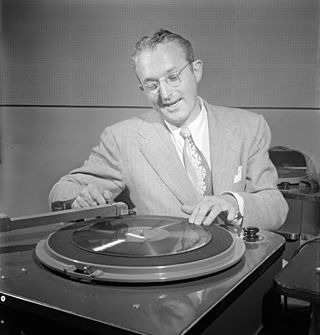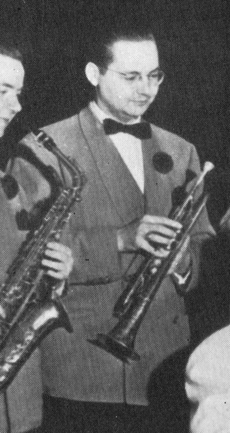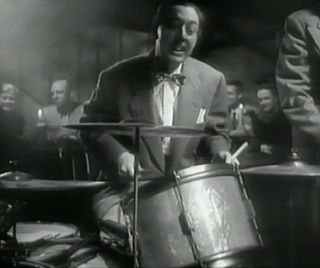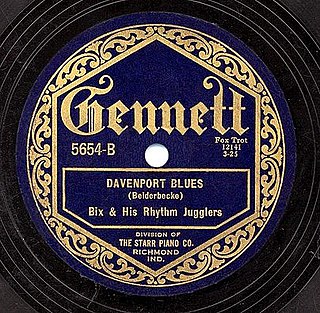
Ernest Loring "Red" Nichols was an American jazz cornetist, composer, and jazz bandleader. He was one of the most prolific and influential jazz musicians in the late 1920s and early 1930s, appearing on over 4,000 recordings. In 1959, a biopic was made of his life and career, The Five Pennies, starring Danny Kaye.

Thomas Francis Dorsey Jr. was an American jazz trombonist, composer, conductor and bandleader of the big band era. He was known as the "Sentimental Gentleman of Swing" because of his smooth-toned trombone playing. His theme song was "I'm Getting Sentimental Over You". His technical skill on the trombone gave him renown among other musicians. He was the younger brother of bandleader Jimmy Dorsey. After Dorsey broke with his brother in the mid-1930s, he led an extremely successful band from the late 1930s into the 1950s. He is best remembered for standards such as "Opus One", "This Love of Mine" featuring Frank Sinatra on vocals, "Song of India", "Marie", "On Treasure Island", and his biggest hit single, "I'll Never Smile Again".

Eugene Bertram Krupa was an American jazz drummer, bandleader, and composer. Krupa is widely regarded as one of the most influential drummers in the history of popular music. His drum solo on Benny Goodman's 1937 recording of "Sing, Sing, Sing" elevated the role of the drummer from that of an accompanist to that of an important solo voice in the band.

Bernard "Buddy" Rich was an American jazz drummer, songwriter, conductor, and bandleader. He is considered one of the most influential drummers of all time.

Louie Bellson, often seen in sources as Louis Bellson, although he himself preferred the spelling Louie, was an American jazz drummer. He was a composer, arranger, bandleader, and jazz educator, and is credited with pioneering the use of two bass drums.

Charles James Shavers was an American jazz trumpeter who played with Dizzy Gillespie, Nat King Cole, Roy Eldridge, Johnny Dodds, Jimmie Noone, Sidney Bechet, Midge Williams, Tommy Dorsey, and Billie Holiday. He was also an arranger and composer, and one of his compositions, "Undecided", is a jazz standard.
Newell "Spiegle" Willcox was a jazz trombonist. He was born Newell Lynn Willcox in upstate New York, and learned valve trombone as a youngster under the tuition of his father, Lynn Willcox, an amateur musician and bandleader. As a student of Manlius Military Academy, where he also played in the school brass band, he acquired the familiar nickname Spiegle, after one of the horses from the Academy's stables which, according to his fellow students, he apparently resembled!

Clyde Lanham Hurley, Jr. was a trumpeter during the big band era. He was born in Fort Worth, Texas to Clyde Lanham Hurley and Esther Brown. Scott Yanow describes Hurley as "a fine trumpeter with a fat tone and a hard-driving style". He died of a coronary occlusion in Fort Worth leaving two sons and a former wife.

Ray Bauduc was an American jazz drummer best known for his work with the Bob Crosby Orchestra and their band-within-a-band, the Bobcats, between 1935 and 1942. He is also known for his shared composition of "Big Noise from Winnetka," a jazz standard.

The Fabulous Dorseys is a 1947 American musical biopic film directed by Alfred E. Green. It tells the story of the brothers Tommy and Jimmy Dorsey, from their boyhood in Shenandoah, Pennsylvania through their rise, their breakup, and their personal reunion. The film was also released under the alternative title The Fighting Dorseys.

The Five Pennies is a 1959 American biographical music drama film in VistaVision and Technicolor starring Danny Kaye as jazz cornet player and bandleader Loring "Red" Nichols. Other cast members include Barbara Bel Geddes, Louis Armstrong, Harry Guardino, Bob Crosby, Bobby Troup, Susan Gordon, and Tuesday Weld. The film was directed by Melville Shavelson.

James Dugald "Jimmy" McPartland was an American cornetist. He worked with Eddie Condon, Art Hodes, Gene Krupa, Benny Goodman, Jack Teagarden, and Tommy Dorsey, often leading his own bands. He was married to pianist Marian McPartland.

Einar Aaron Swan was an American musician, arranger and composer. He is known for writing songs including "When Your Lover Has Gone" and "In the Middle of a Dream".
Warren Covington was an American big band trombonist. He was active as a session musician, arranger, and bandleader throughout his career.
Steve Philip Jordan was an American jazz guitarist.

Arthur Schutt was an American jazz pianist and arranger.

"I'm Glad There Is You (In This World of Ordinary People)" is a song written by Jimmy Dorsey and Paul Madeira (sometimes credited as Paul Mertz) first published in 1941. It has become a jazz and pop standard.

Davenport Blues is a 1925 jazz composition written and recorded by Bix Beiderbecke and released as a Gennett 78. The song has become a jazz and pop standard.
Joseph Claude Caputo,, known professionally as Joe Cabot, was an American jazz trumpeter, bandleader, and musical director. His composition "Slow Down, Sugar, Take Your Time," was praised by music critic John Wilson and likened to the stylings of the Nat Cole Trio. In addition to trumpet, Cabot played the flugelhorn.
Karl Kiffe was an American jazz drummer featured in specialty numbers in a number of Hollywood feature films during World War II and later as a featured member of Jimmy Dorsey's orchestra.















